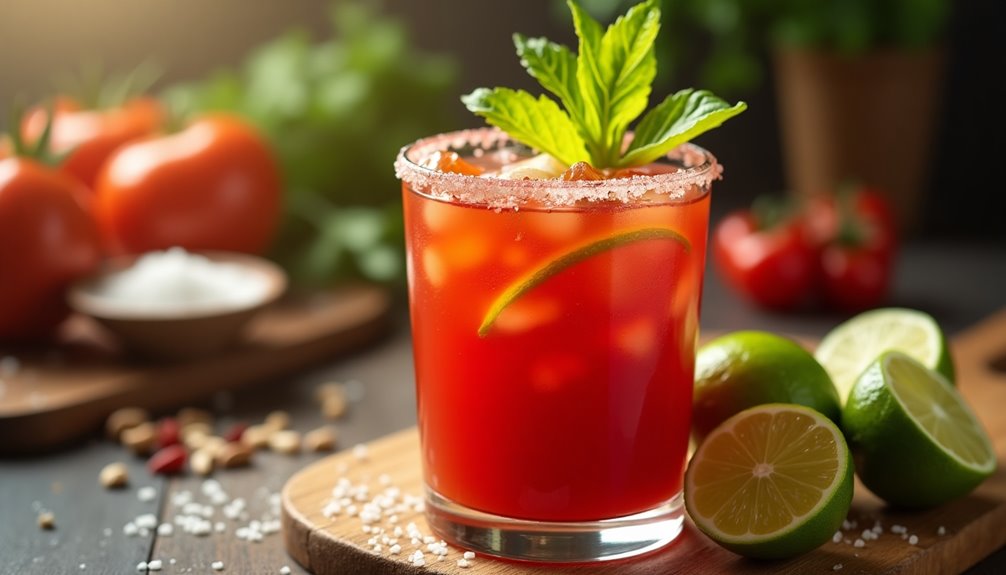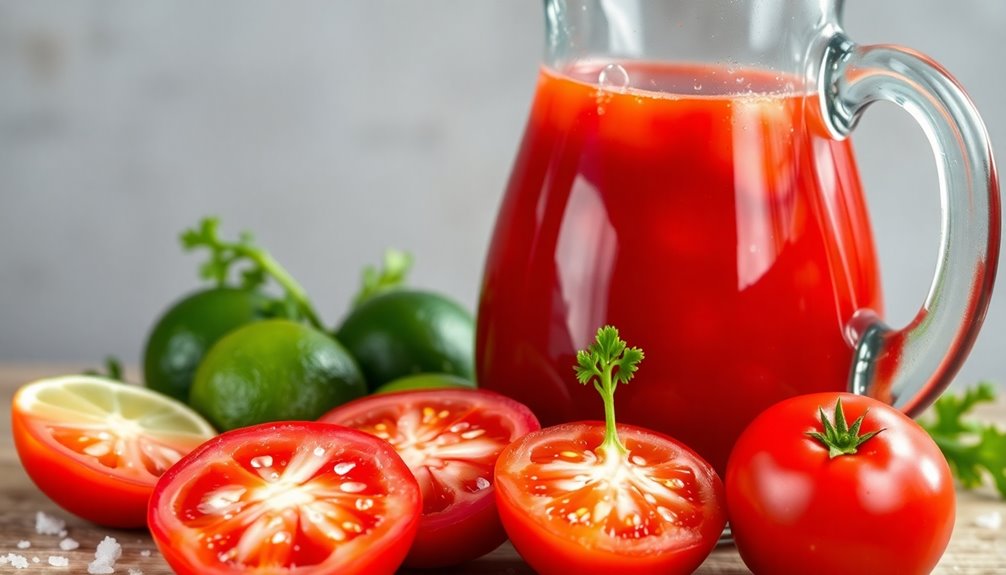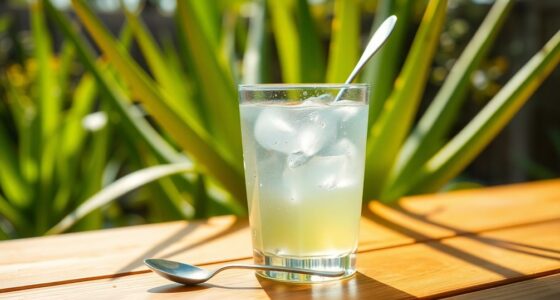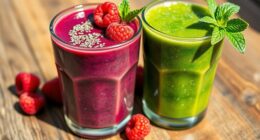To make Clamato juice, you'll need to mix 3 cups of tomato juice, 1 cup of clam juice, and ½ cup of fresh lemon juice in a bowl. Add ¼ cup of Worcestershire sauce, a few dashes of hot sauce, celery salt, sea salt, and black pepper to taste. Stir it all together, then chill it in the refrigerator for at least an hour. Serve it over ice, and you'll be ready for a refreshing drink! Keep going to explore serving suggestions and storage tips.
Key Takeaways
- Combine 3 cups of tomato juice, 1 cup of clam juice, and ½ cup of fresh lemon juice in a mixing bowl.
- Add ¼ cup of Worcestershire sauce and dashes of hot sauce, celery salt, sea salt, and black pepper to taste.
- Stir the mixture until all ingredients are well combined.
- Refrigerate the mixed Clamato juice for at least one hour to allow flavors to meld.
- Serve chilled over ice and garnish with celery sticks or pickled vegetables.

If you're craving a refreshing and savory drink, making your own Clamato juice is a breeze. This delicious blend combines the rich flavors of tomato juice and clam juice, creating a unique beverage that's perfect for sipping on its own or using as a base for cocktails like the Bloody Caesar. Plus, once you try your hand at this homemade version, you might find you prefer it over store-bought options.
To get started, gather your ingredients. You’ll need three cups of tomato juice, one cup of clam juice, and half a cup of fresh lemon juice. The lemon juice adds a zesty kick that balances out the savory notes from the clam juice. In a mixing bowl, combine these ingredients, ensuring they mix well. The vibrant red color of the tomato juice combined with the subtle brininess of the clam juice creates a visually appealing drink that’s sure to impress. Next, you’ll want to chill your mixture in the refrigerator for at least an hour to enhance the flavors. While it cools, you might consider reading up on how to prepare clam juice if you’re interested in making your own from fresh clams. Once chilled, serve the drink over ice and garnish with a lemon wedge for an extra touch of freshness that complements the zesty kick perfectly.
To elevate the flavor even further, add a quarter cup of Worcestershire sauce. This sauce brings a depth of umami that really enhances the overall taste of your Clamato juice. Don't forget the heat! Just a couple of dashes of hot sauce will give your drink that extra zing, making it even more refreshing. Finally, season your mixture with celery salt, sea salt, and black pepper to taste. These seasonings will round out the flavors, making each sip more satisfying.
Once you've mixed everything together, stir the concoction until it's well combined. Now, transfer your homemade Clamato juice to a pitcher and refrigerate it for at least one hour. This chilling time allows the flavors to meld beautifully, resulting in a more cohesive taste when you finally serve it. There's something truly delightful about the way the ingredients come together, creating a savory drink that's both satisfying and refreshing.
When you're ready to serve, pour the chilled Clamato juice over ice for an ultra-refreshing experience. You can savor it on its own or use it as a base for your favorite cocktails. A classic choice is the Bloody Caesar, which combines Clamato juice with vodka, a squeeze of lemon, and garnishes like celery sticks or pickled vegetables. It's a crowd-pleaser at brunches or gatherings and is perfect for those who enjoy bold, savory flavors.
If you happen to have any leftovers, don't worry! You can store your Clamato juice in an airtight container in the refrigerator for up to one week. Just give it a stir before serving to recombine the ingredients, and you'll have a quick and easy savory drink ready to enjoy whenever you want. With this simple recipe, you'll always have a refreshing drink at your fingertips!
Frequently Asked Questions
What Are the Ingredients in Clamato?
If you're curious about the ingredients in Clamato, you're in for a treat!
It combines tomato juice and clam juice or broth, typically in a ratio of 3 cups tomato juice to 1 cup clam juice.
You'll also want to add lemon juice, Worcestershire sauce, and a few dashes of hot sauce for that extra kick.
Season it to your liking with celery salt, sea salt, and black pepper, and customize as you please!
What Is a Substitute for Clamato Juice?
Did you know that about 80% of people enjoy savory drinks?
If you're looking for a substitute for Clamato juice, try mixing equal parts tomato juice and clam broth for a similar flavor.
If you don't have clam broth, vegetable broth or fish sauce works too, though it'll change the taste a bit.
For a non-seafood option, blend tomato juice with soy sauce and hot sauce for a savory kick.
Adjust seasoning to your taste!
What Are the Ingredients in Mott's Clamato Juice?
If you're curious about what's in Mott's Clamato Juice, you'll find a blend of tomato juice and clam broth at its core.
It's seasoned with ingredients like Worcestershire sauce, hot sauce, lemon juice, celery salt, and black pepper, giving it that distinctive savory taste.
You can also choose from various options, like original, spicy, or low sodium, to suit your flavor preferences.
Enjoy it as a refreshing drink or a cocktail base!
Is There Actual Clam Juice in Clamato?
You won't believe the flavor explosion in Clamato! Yes, there's actual clam juice in it, which gives this unique beverage its savory and oceanic taste.
The clam juice is derived from real clams, blended with tomato juice to create that iconic profile.
Conclusion
In the world of beverages, "variety is the spice of life," and making your own Clamato juice is a fantastic way to add some zest to your drink repertoire. With just a few simple ingredients, you can whip up a refreshing, tangy treat that's perfect for cocktails or sipping solo. So, grab those tomatoes and clams, and let your creativity flow. You'll impress your friends and elevate your next gathering with this homemade delight! Enjoy!
Cindy thoroughly researches juicing trends, techniques, and recipes to provide readers with practical advice and inspiration. Her writing style is accessible, engaging, and designed to make complex concepts easy to understand. Cindy’s dedication to promoting the advantages of juicing shines through her work, empowering readers to make positive changes in their lives through the simple act of juicing.











